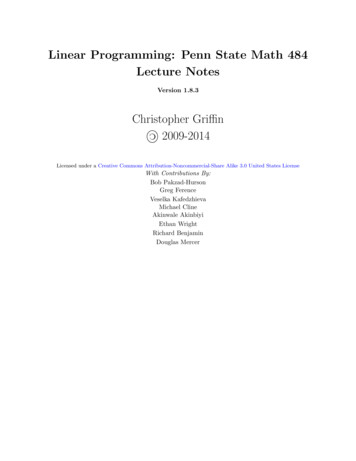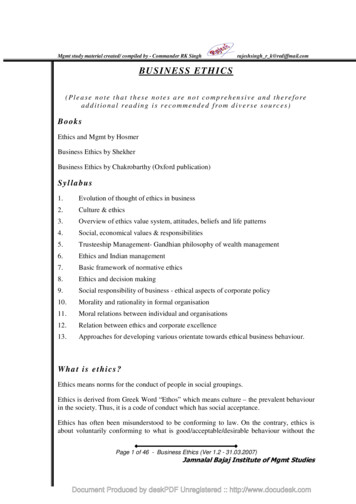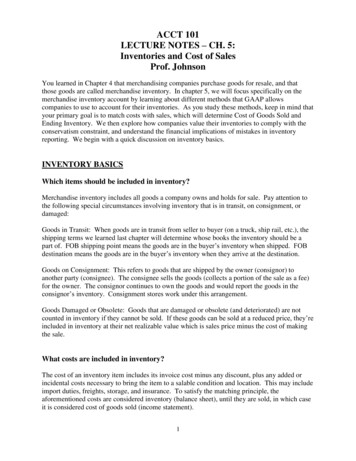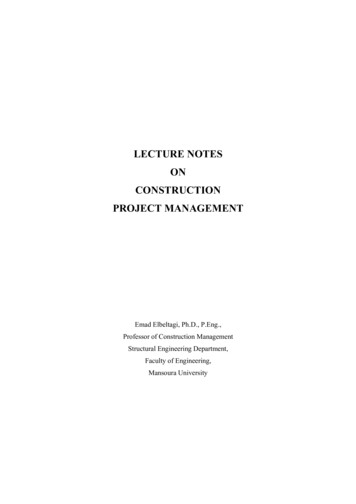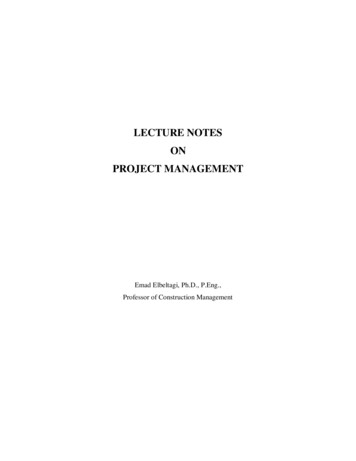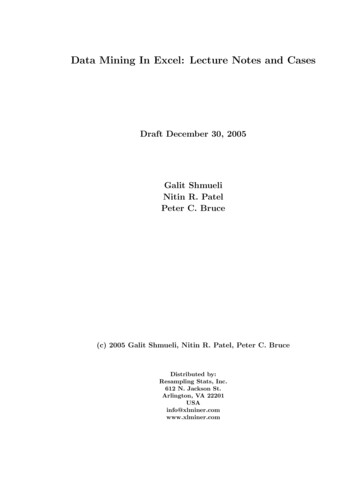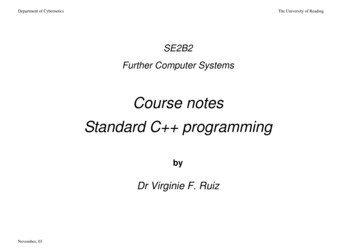
Transcription
Department of CyberneticsThe University of ReadingSE2B2Further Computer SystemsCourse notesStandard C programmingbyDr Virginie F. RuizNovember, 03
VFR November, 03STRUCTURE OF THE COURSE .3GENERALITY .3SIMPLE OBJECTS.3DERIVED CLASSES .3TEMPLATES .3STREAMS .3C BOOKS .3FOR WINDOWS:. Error! Bookmark not defined.GENERALITY .4AN OVERVIEW OF C .4OBJECT ORIENTED PROGRAMMING (OOP) .4DIFFERENCES BETWEEN C AND C .5DIFFERENCES BETWEEN C AND STANDARD C .6C CONSOLE I/O .7C AND C COMMENTS.7CLASSES .8FUNCTION OVERLOADING: AN INTRODUCTION .9CONSTRUCTORS AND DESTRUCTORS FUNCTIONS .10CONSTRUCTORS .10DESTRUCTORS .10CONSTRUCTORS THAT TAKE PARAMETERS .11INHERITANCE: AN INTRODUCTION .11OBJECT POINTERS .13IN-LINE FUNCTIONS.13AUTOMATIC IN-LINING .14MORE ABOUT CLASSES .14ASSIGNING OBJECT .14PASSING OBJECT TO FUNCTIONS .15RETURNING OBJECT FROM FUNCTIONS .16FRIEND FUNCTIONS: AN INTRODUCTION .16ARRAYS, POINTERS, AND REFERENCES .18ARRAYS OF OBJECTS .18USING POINTERS TO OBJECTS .19THE THIS POINTER .20USING NEW AND DELETE.20MORE ABOUT NEW AND DELETE .21REFERENCES .22PASSING REFERENCES TO OBJECTS .23RETURNING REFERENCES .24INDEPENDENT REFERENCES AND RESTRICTIONS .25SE2B2 Further Computer SystemsCREATING AND USING A COPY CONSTRUCTOR . 27USING DEFAULT ARGUMENTS . 29OVERLOADING AND AMBIGUITY . 30FINDING THE ADDRESS OF AN OVERLOADED FUNCTION. 30OPERATOR OVERLOADING. 31THE BASICS OF OPERATOR OVERLOADING . 31OVERLOADING BINARY OPERATORS . 32OVERLOADING THE RELATIONAL AND LOGICAL OPERATORS . 34OVERLOADING A UNARY OPERATOR . 34USING FRIEND OPERATOR FUNCTIONS . 35A CLOSER LOOK AT THE ASSIGNMENT OPERATOR . 37OVERLOADING THE [ ] SUBSCRIPT OPERATOR . 38INHERITANCE. 39BASE CLASS ACCESS CONTROL . 39USING PROTECTED MEMBERS . 40CONSTRUCTORS, DESTRUCTORS, AND INHERITANCE . 41MULTIPLE INHERITANCE . 43VIRTUAL BASE CLASSES. 45VIRTUAL FUNCTIONS . 46POINTERS TO DERIVED CLASS . 46INTRODUCTION TO VIRTUAL FUNCTIONS . 47MORE ABOUT VIRTUAL FUNCTIONS . 49APPLYING POLYMORPHISM . 51C I/O SYSTEM. 53SOME C I/O BASICS . 53CREATING YOUR OWN INSERTERS . 54CREATING EXTRACTORS . 55MORE C I/O BASICS . 56FORMATTED I/O. 57USING WIDTH( ), PRECISION( ), AND FILL( ). 58USING I/O MANIPULATORS . 59ADVANCE C I/O . 60CREATING YOUR OWN MANIPULATORS . 60FILE I/O BASICS. 60UNFORMATTED, BINARY I/O . 63MORE UNFORMATTED I/O FUNCTIONS . 64RANDOM ACCESS . 65CHECKING THE I/O STATUS . 66CUSTOMISED I/O AND FILES . 67TEMPLATES AND EXCEPTION HANDLING. 68GENERIC FUNCTIONS. 68GENERIC CLASSES . 70EXCEPTION HANDLING . 72MORE ABOUT EXCEPTION HANDLING . 74HANDLING EXCEPTIONS THROWN BY NEW . 76FUNCTION OVERLOADING.25OVERLOADING CONSTRUCTOR FUNCTIONS .25Standard C programming2
VFR November, 03SE2B2 Further Computer SystemsSTRUCTURE OF THE COURSEGeneralityAn overview of C Object Oriented Programming (OOP)Differences between C and C Differences between traditional C and Standard C Simple objectsClasses and objects, constructors, destructors, operators.Derived ClassesSimple inheritance, protecting data, virtual function, pointer and inheritance,multiple inheritance.C BOOKSProblem Solving with C (4th edition)Walter SavitchAddison Wesley 2002ISBN: 032111347-0Computing fundamentals with C , Object oriented programming & design(2nd edition)Rick MercerMacMillan Press ISBN 0333-92896-2Object Oriented Neural Networks in C Joey RogersAcademic Press ISBN 01259311581TemplatesGeneric functions and classesException handlingTeach yourself C Author: H. SchildtPublisher: OsborneISBN 0-07-882392-7StreamsC I/O System1Standard C programmingThe notes are extracted from this book3
VFR November, 03SE2B2 Further Computer SystemsObject Oriented Programming (OOP)GENERALITYAn overview of C C is the object oriented extension of C. As for C there is an ANSI/ISOstandard ( final draft 1998) for the C programming language. This will ensurethat the C code is portable between computers.The C programming language teach here is the Standard C . This is theversion of C created by the ANSI/ISO2 standardisation committee. TheStandard C contains several enhancements not found in the traditional C .Thus, Standard C is a superset of traditional C .Standard C is the one that is currently accepted by all major compilers.Therefore, you can be confident that what you learn here will also apply in thefuture.However, if you are using an older compiler it might not support one or more ofthe features that are specific to Standard C . This is important because tworecent additions to the C language affect every program you will write. If youare using an older compiler that does not accept these knew features, don’t worry.There is an easy workaround, as you will in a later paragraph.Although structured programming has yielded excellent results when applied tomoderately complex programs, even it fails at some point, after a program reachesa certain size. To allow more complex programs to be written, object-orientedprogramming has been invented. OOP takes the best of the ideas in structuredprogramming and combines them with powerful new concepts that allow you toorganise your programme more efficiently.Object oriented programming encourage you to decompose a problem into itsconstituent parts.Each component becomes a self-contained object that contains its owninstructions and data that relate to that object. In this way, complexity is reducedand the programmer can manage larger program.All OOP languages, including C , share three common defining traits.EncapsulationEncapsulation is the mechanism that binds together code and the data itmanipulates, and keeps them both safe from outside. In an object-orientedlanguage, code and data can be combined in such a way that a self-contained‘black box’ is created. When code and data are link together in this fashion , anobject is created:OBJECTDataSince C was invented to support object-oriented programming. OOP conceptswill be reminded. As you will see, many features of C are related to OOP in away or another. In fact the theory of OOP permeates C . However, it isimportant to understand that C can be used to write programs that are and arenot object oriented. How you use C is completely up to you.A few comments about the nature and form of C are in order. For most partC programs look like C programs. Like a C program, a C program beginsexecution at m a i n ( ) . To include command-line arguments, C uses the samea r g c , a r g v convention that C uses. Although C defines its own, objectoriented library. It also supports all the functions in the C standard library. C uses the same control structures as C. C includes all the build-in data typesdefined by C programming.2ANSI: American National Standards InstituteISO: International Standard OrganisationStandard C programmingMethods: codeWithin an object, code, data, or both may be private to that object or public.Private code or data is known to and accessible only by another part of the object(i.e. cannot be accessed by a piece of the program that exists outside the object.Public code or data can be accessed by other parts of the program even though itis defined within an object.Public parts of an object are used to provide a controlled interface to the privateelements of the object.4
VFR November, 03SE2B2 Further Computer SystemsAn object is a variable of a user-defined type. Each time you define a new type ofobject, you are creating a new data type. Each specific instance of this data type isa compound variable.char f1( );PolymorphismPolymorphism is the quality that allows one name to be used for two or morerelated but technically different purposes.Polymorphism allows one name to specify a general class of actions. Within ageneral class of actions, the specific action to be applied is determined by the typeof data. For example, in C, the absolute value action requires three distinctfunction names: a b s ( ) for integer, l a b s ( ) for long integer, and f a b s ( ) forfloating-point value. However in C , each function can be called by the samename, such as a b s ( ) . The type of data used to call the function determineswhich specific version of the function is actually executed.In C it is possible to use one function name for many different purposes. Thistype of polymorphism is called function overloading.Polymorphism can also be applied to operators. In that case it is called operatoroverloading.More generally the concept of polymorphism is characterised by the idea ‘oneinterface, multiple methods’. The key point to remember about polymorphism isthat it allows you to handle greater complexity by allowing the creation ofstandard interfaces to related activities.InheritanceInheritance is the process by which one object can acquire the properties ofanother. An object can inherit a general set of properties to which it can add thosefeatures that are specific only to itself.Inheritance is important because it allows an object to support the concept ofhierarchical classification. Most information is made manageable by hierarchicalclassification.The child class inherits all those qualities associated with the parent and adds tothem its own defining characteristics.Differences between C and C Although C is a subset of C, there are some small differences between the two,and few are worth knowing from the start.First, in C, when a function takes no parameters, its prototype has the word v o idinside its function parameter list. For example if a function f 1 ( ) takes noparameters (and returns a c h a r), its prototype will look like this:char f1(void);Standard C programmingIn C , the void is optional. Therefore the prototype for f1( ) is usuallywritten as:/* C version *///C versionthis means that the function has no parameters. The use of v o id in C is notillegal; it is just redundant. Remember these two declarations are equivalent.Another difference between C and C is that in a C program, all functionsmust be prototyped. Remember in C prototypes are recommended but technicallyoptional. As an example from the previous section show, a member function’sprototype contained in a class also serves as its general prototype, and no otherseparate prototype is required.A third difference between C and C is that in C , if a function is declared asreturning a value, it must return a value. That is, if a function has a return typeother than v o id , any r e t u r n statement within the function must contain a value.In C, a non v o id function is not required to actually return a value. If it doesn’t, agarbage value is ‘returned’.In C , you must explicitly declare the return type of all functions.Another difference is that in C, local variables can be declared only at the start ofa block, prior to any ‘action’ statement. In C , local variables can be declaredanywhere. Thus, local variables can be declared close to where they are first useto prevent unwanted side effects.C defines the b o o l date type, which is used to store Boolean values. C alsodefines the keywords t r u e and f a l s e , which are the only values that a value oftype b o o l can have.In C, a character constant is automatically elevated to an integer, whereas in C it is not.In C, it is not an error to declare a global variable several times, even though it isbad programming practice. In C , this is an error.In C an identifier will have at least 31 significant characters. In C , allcharacters are considered significant. However, from practical point of view,extremely long identifiers are unwieldy and seldom needed.In C, you can call m a i n ( ) from within the program. In C , this is not allowed.5
VFR November, 03SE2B2 Further Computer SystemsIn C, you cannot take the address of a r e g i s t e r variable. In C , you can.In C, the type w c h a r t is defined with a t y p e d e f . In C , w c h a r t is akeyword.Differences between C and Standard C The traditional C and the Standard C are very similar. The differencesbetween the old-style and the modern style codes involve two new features: newstyle headers and the n a m e s p a c e statement. Here an example of a do-nothingprogram that uses the old style,/*A traditional-style C program#include iostream.h int main( ) {/* program code */return 0;} iostream fstream vector string Standard C supports the entire C function library, it still supports the C-styleheader files associated with the library. That is, header files such as s t d i o . h andc t y p e . h are still available. However Standard C also defines new-styleheaders that you can use in place of these header files. For example,*/New headersSince C is build on C, the skeleton should be familiar, but pay attention to the# i n c l u d e statement. This statement includes the file i o s t r e a m . h , whichprovides support for C ’s I/O system. It is to C what s t d i o . h is to C.Here the second version that uses the modern style,/*A modern-style C program that usesthe new-style headers and namespace*/#include iostream using namespace std;int main( ) {/* program code */return 0;}First in the # i n c l u d e statement, there is no . h after the name i o s t r e a m . Andsecond, the next line, specifying a namespace is new.The only difference is that in C or traditional C , the # i n c l u d e statementincludes a file (file-name. h ). While the Standard C do not specify filenames.Instead the new style headers simply specify standard identifiers that might bemap to files by the compiler, but they need not be. New headers are abstractionsthat simply guaranty that the appropriate prototypes and definitions required byStandard C programmingthe C library have been declared.Since the new-style header is not a filename, it does not have a . h extension.Such header consists only of the header name between angle brackets:Old style header files math.h string.h Standard C headers cmath cstring Remember, while still common in existing C code, old-style headers areobsolete.NamespaceWhen you include a new-style header in your program, the contents of that headerare contained in the s t d namespace. The namespace is simply a declarativeregion. The purpose of a namespace is to localise the names of identifiers to avoidname collision. Traditionally, the names of library functions and other such itemswere simply placed into the global namespace (as they are in C). However, thecontents of new-style headers are place in the s t d namespace. Using thestatement,using namespace std;brings the s t d namespace into visibility. After this statement has been compiled,there is no difference working with an old-style header and a new-style one.Working with an old compilerIf you work with an old compiler that does not support new standards: simply usethe old-style header and delete the n a m e s p a c e statement, i.e.replace:by:#include iostream #include iostream.h 6
VFR November, 03SE2B2 Further Computer Systemscout "i " i " f " f "\n";// output i then f and newlinereturn 0;using namespace std;}C CONSOLE I/OSince C is a superset of C, all elements of the C language are also contained inthe C language. Therefore, it is possible to write C programs that look justlike C programs. There is nothing wrong with this, but to take maximum benefitfrom C , you must write C -style programs.You can input any items as you like in one input statement. As in C, individualdata items must be separated by whitespace characters (spaces, tabs, or newlines).When a string is read, input will stop when the first whitespace character isencountered.C AND C COMMENTSThis means using a coding style and features that are unique to C ./*The most common C -specific feature used is its approach to console I/O.While you still can use functions such as p r i n t f ( ) and s c a n f ( ) , C I/O isperformed using I/O operators instead of I/O functions.The output operator is . To output to the console, use this form of the operator:cout expression;This is a C-like comment.The program determines whetheran integer is odd or even.*/#include iostream using namespace std;int main( ) {int num;// This is a C single-line comment.where expression can be any valid C expression, including another outputexpression.// read the numbercout "Enter number to be tested: ";cin num;cout "This string is output to the screen.\n";cout 236.99;// see if even or oddif ((num%2) 0) cout "Number is even\n";else cout "Number is odd\n";The input operator is . To input values from keyboard, usecin variables;return 0;}Example:#include iostream using namespace std;int main( ) {// local variablesint i;float f;// program codecout "Enter an integer then a float ";// no automatic newlinecin i f;// input an integer and a floatStandard C programmingMultiline comments cannot be nested but a single-line comment can be nestedwithin a multiline comment./* This is a multiline commentInside which // is nested a single-line comment.Here is the end of the multiline comment.*/7
VFR November, 03SE2B2 Further Computer SystemsCLASSESIn C , a class is declared using the c l a s s keyword. The syntax of a classdeclaration is similar to that of a structure. Its general form is,class class-name {// private functions and variablespublic:// public functions and variables} object-list;In a class declaration the object-list is optional.The class-name is technically optional. From a practical point of view it isvirtually always needed. The reason is that the class-name becomes a new typename that is used to declare objects of the class.Functions and variables declared inside the class declaration are said to bemembers of the class.By default, all member functions and variables are private to that class. Thismeans that they are accessible by other members of that class.To declare public class members, the p u b l i c keyword is used, followed by acolon. All functions and variables declared after the p u b l i c specifier areaccessible both by other members of the class and by any part of the program thatcontains the class.#include iostream using namespace std;// class declarationclass myclass {// private members to myclassint a;public:// public members to myclassvoid set a(int num);int get a( );};This class has one private variable, called a , and two public functions s e t a ( )and g e t a ( ) . Notice that the functions are declared within a class using theirprototype forms. The functions that are declared to be part of a class are calledmember functions.Standard C programmingSince a is private it is not accessible by any code outside m y c l a s s . Howeversince s e t a ( ) and g e t a ( ) are member of m y c l a s s , they have access to aand as they are declared as public member of m y c l a s s , they can be called byany part of the program that contains m y c l a s s .The member functions need to be defined. You do this by preceding the functionname with the class name followed by two colons (:: are called scope resolutionoperator). For example, after the class declaration, you can declare the memberfunction as// member functions declarationvoid myclass::set a(int num) {a num;}int myclass::get a( ) {return a;}In general to declare a member function, you use this form:return-type class-name::func-name(parameter- list){// body of function}Here the class-name is the name of the class to which the function belongs.The declaration of a class does not define any objects of the type m y c l a s s . Itonly defines the type of object that will be created when one is actually declared.To create an object, use the class name as type specifier. For example,// from previous examplesvoid main( ) {myclass ob1, ob2;//these are object of type myclass// . program code}Remember that an object declaration creates a physical entity of that type. That is,an object occupies memory space, but a type definition does not.Once an object of a class has been created, your program can reference its publicmembers by using the dot operator in much the same way that structure membersare accessed. Assuming the preceding object declaration, here some examples,.8
VFR November, 03ob1.set a(10);ob2.set a(99);SE2B2 Further Computer Systems// set ob1’s version of a to
The C programming language teach here is the Standard C . This is the version of C created by the ANSI/ISO2 standardisation committee. The Standard C contains several enhancements not found in the traditional C . Thus, Standard C is a superset of traditional C . Standard C is the one that is currently accepted by all major compilers.File Size: 951KB

